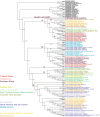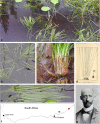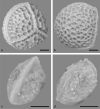Phylogeny of Merlin's grass (Isoetaceae): revealing an "Amborella syndrome" and the importance of geographic distribution for understanding current and historical diversity
- PMID: 35296231
- PMCID: PMC8928685
- DOI: 10.1186/s12862-022-01988-w
Phylogeny of Merlin's grass (Isoetaceae): revealing an "Amborella syndrome" and the importance of geographic distribution for understanding current and historical diversity
Abstract
Background: Merlin's grass (Isoetes, Isoetaceae, Lycopsida), is the extant remnant of the isoetalean wood-producing lycopsids that originated during the Paleozoic, possibly in aquatic or boggy habitats. Modern day species are aquatic, semi-aquatic or terrestrial and occur almost worldwide. They display little morphological variation; the lobed corm has helically arranged leaves with internal air channels and basal sporangia. Genetic variation has also proven limited, which has hampered phylogenetic inference. We investigate evolutionary relationships in Isoetes, using molecular data and an extended sample of species compared to previous work, adding species that have never before been included in a phylogenetic study.
Results: Our results reveal an unexpected discovery of an "Amborella syndrome" in Isoetaceae: a single poorly known species is sister to the remaining family. The species, Isoetes wormaldii, is a rare endemic to the Eastern Cape of South Africa. Its leaves are flattened with a rounded point, which sharply contrasts with the awl-shaped leaves of most other species of Isoetes. The remaining species of Isoetes are resolved in five major clades, also indicated in previous work. While the phylogeny shows geographic structure, the patterns are complex. For example, tropical-southern African species occur in at least five clades, and Indian, Australian and Mediterranean species in at least three clades each.
Conclusion: The evolutionary and biogeographical history of Isoetes is not easily explained, and may conceivably include ample extinction and a mixture of ancient and more recent processes. Previously shown difficulties with node age estimation increase the problem. The here demonstrated sister-relationship between the phylogenetically, morphologically and genetically distinct Isoetes wormaldii and the remaining family appears to bridge the morphological gap between Isoetes and its extinct relatives, although further studies are needed. Moreover, it shortens the branch length to its living sister genus Selaginella, and may enhance node age estimation in future studies. Isoetes wormaldii is critically endangered, known only from one (to a few) minor populations. Immediate actions need to be taken if we want to prevent this unique species from going extinct.
Keywords: Dispersal; Eastern Cape; Isoetes; Isoetes wormaldii; Phylogeny; Polyploidy; Speciation; Species distribution.
© 2022. The Author(s).
Conflict of interest statement
The authors declare that they have no competing interests.
Figures



References
-
- DiMichele WA, Bateman RM. The rhizomorphic lycopsids: a case-study in paleobotanical classification. Syst Bot. 1996;21(4):535–552.
-
- Underwood LM. The distribution of Isoetes. Bot Gaz. 1888;13(4):89–94.
-
- Troìa A, Pereira JB, Kim C, Taylor WC. The genus Isoetes (Isoetaceae): a provisional checklist of the accepted and unresolved taxa. Phytotaxa. 2016;277(2):101–145.
-
- Pfeiffer NE. Monograph of the Isoetaceae. Ann Mo Bot Gard. 1922;9:79–232.
-
- Jermy AC. Isoetaceae. In: Kramer KU, Green PS, editors. Pteridophytes and gymnosperms. The families and genera of vascular plants. Berlin: Springer Verlag; 1990. pp. 26–31.
Publication types
MeSH terms
Substances
LinkOut - more resources
Full Text Sources
Miscellaneous
